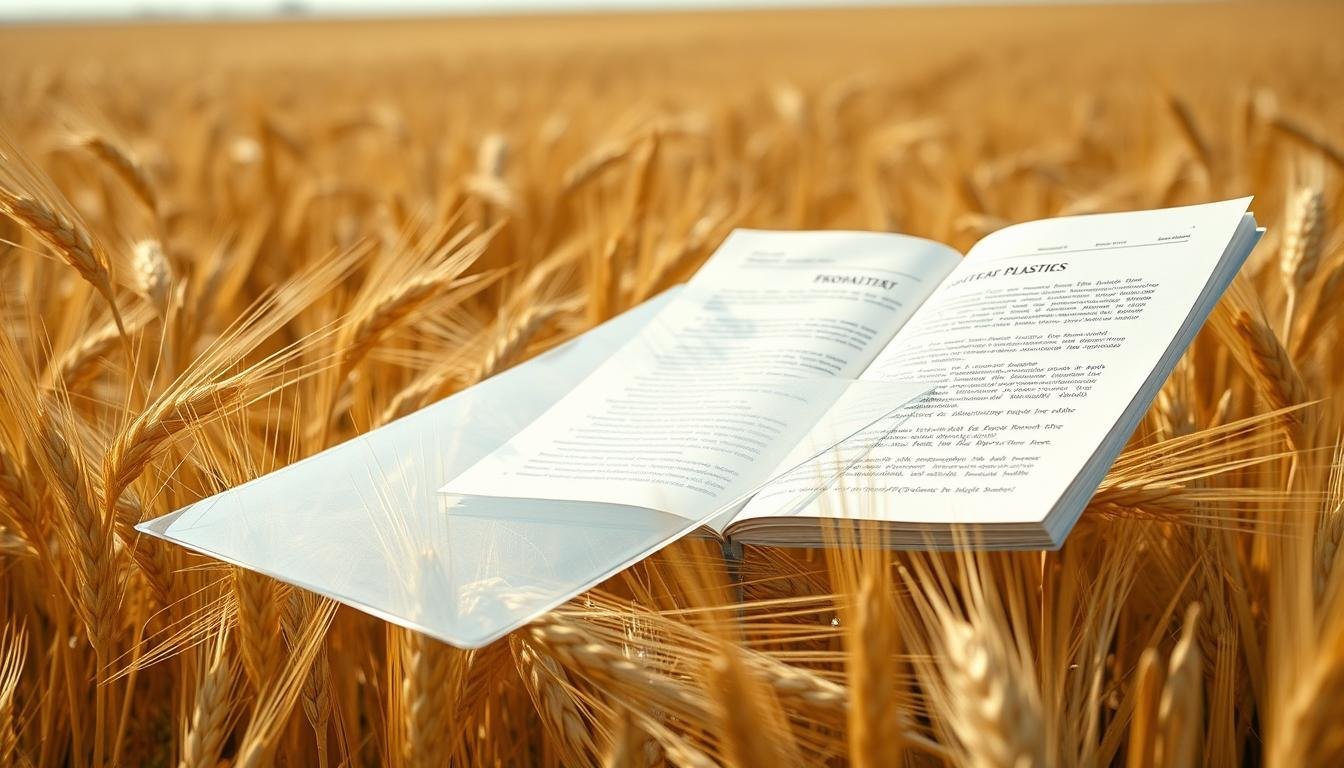You might have seen products made from wheat straw plastic. It’s a bioplastic that’s different from regular plastics. As worries about plastic waste increase, rules on plastic use are getting tighter, especially in Europe.
The European Union is leading the way in plastic regulations to lessen environmental harm. If you’re curious about wheat straw plastic in Europe, this article has the answers you need.
We’ll look into the current rules and what they mean for you. This is important whether you’re a shopper or a business wanting to be more eco-friendly.
Contents
- 1 What Is Wheat Straw Plastic?
- 2 Current Regulatory Framework for Bioplastics in Europe
- 3 Is Wheat Straw Plastic Banned in Europe?
- 4 Wheat Straw Plastic vs. Conventional Plastics
- 5 Benefits and Limitations of Wheat Straw Plastic
- 6 Implications for US Businesses and Consumers
- 7 Conclusion
- 8 FAQ
- 8.1 What is wheat straw plastic?
- 8.2 Is wheat straw plastic biodegradable?
- 8.3 What are the benefits of using wheat straw plastic?
- 8.4 Are there any limitations to using wheat straw plastic?
- 8.5 How does wheat straw plastic compare to conventional plastics?
- 8.6 Is wheat straw plastic banned in Europe?
- 8.7 What are the implications of wheat straw plastic’s regulatory status for US businesses?
- 8.8 How does the production process of wheat straw plastic work?
- 8.9 Can wheat straw plastic be used for packaging?
- 8.10 What is the future outlook for wheat straw plastic?
What Is Wheat Straw Plastic?
Bioplastics, like those from wheat straw, are a great alternative to regular plastics. Wheat straw plastic is made from wheat crop waste. It’s a green material that cuts down on farm waste and fossil fuel use.
To make it, wheat straw is turned into pulp and then into bioplastic. This bioplastic can be shaped into many things. It’s perfect for eco-friendly packaging.
Key Characteristics
Wheat straw plastic has some great qualities. It’s good for businesses and people who want to be green. Here are some of its main points:
| Characteristics | Description | Benefits |
|---|---|---|
| Biodegradable | Made from organic stuff, it breaks down naturally. | It cuts down on plastic waste and pollution. |
| Sustainable | It’s made from farm waste, so we don’t need new stuff. | It saves natural resources and lowers carbon emissions. |
| Compostable | It can be composted, going back to nature. | It helps the economy go full circle and less waste ends up in landfills. |
Wheat straw plastic is a smart choice for companies wanting to be kinder to the planet. With more people caring about the environment, the need for sustainable materials and eco-friendly packaging will only grow.
Current Regulatory Framework for Bioplastics in Europe
Exploring the European market means knowing the rules for bioplastics. The European Union has set clear guidelines for bioplastics, including those made from wheat straw.
The EU’s rules aim to make things more sustainable and cut down on environmental harm. Bioplastics, made from renewable sources like wheat straw, are seen as a good way to tackle plastic waste.
Several EU laws and directives control bioplastics use. The EU’s Directive on Single-Use Plastics tries to lessen marine pollution and encourage biodegradable options.
- The European Bioplastics Association helps EU lawmakers make bioplastics part of the circular economy.
- The Waste Framework Directive guides waste handling, including bioplastics recycling.
Knowing these rules is essential for the European bioplastics market. Whether you’re a business or a consumer, these laws impact you. They’re meant to help us move towards a greener future.
By keeping up with Europe’s bioplastics regulations, you can make better choices. This could be for your business or as a consumer.
Is Wheat Straw Plastic Banned in Europe?
Concerns about plastic waste have led to a closer look at wheat straw plastic in Europe. You might wonder if this bioplastic is allowed in the European market. The European Union has been working to cut down on plastic waste.
Wheat straw plastic is made from agricultural waste and is seen as a greener option than regular plastics. But, its legal status is not simple. The EU’s rules on bioplastics are changing, aiming to lessen environmental harm.
Right now, Europe doesn’t ban wheat straw plastic outright. Instead, it follows the same rules as other bioplastics. Companies must follow EU rules on packaging and waste.
Implications for Manufacturers and Consumers
For makers, this means their wheat straw plastic items must meet EU standards for composting and breaking down. As a buyer, look for “Compostable” or “OK Compost” labels to know it’s eco-friendly.
The rules also shape how we shop. Knowing the green benefits of wheat straw plastic can boost demand for eco-products. This encourages more innovation in the field.
To wrap up, wheat straw plastic isn’t banned in Europe, but it’s tightly regulated. As EU policies on bioplastics evolve, both makers and buyers need to stay updated to use this eco-friendly material wisely.
Wheat Straw Plastic vs. Conventional Plastics
Curious about wheat straw plastic compared to regular plastics? It’s important to know the eco-friendliness and performance differences. This knowledge helps you choose better sustainable packaging options.
Wheat straw plastic is a bioplastic made from farm waste. It cuts down on the use of new materials and lessens environmental harm. On the other hand, regular plastics come from oil, a limited resource. Making these plastics leads to more pollution and greenhouse gases, but wheat straw plastic is a greener choice.
Looking at how wheat straw plastic compares to regular plastics, we see several key points. These include how well they last, their flexibility, and cost. Wheat straw plastic has improved a lot, fitting well in many uses, from packaging to disposable items.
- Durability: Wheat straw plastic is strong and can handle different weather conditions. But, it’s not as tough as some regular plastics.
- Cost: Wheat straw plastic is pricier than regular plastics now because of the cost of making bioplastics. But, as more people use it and technology gets better, prices should drop.
Thinking about switching to wheat straw plastic? It’s key to balance the eco-friendly benefits with the higher costs. The long-term environmental gains and possible savings from less waste and following green rules make it a good choice for eco-conscious businesses.
Benefits and Limitations of Wheat Straw Plastic
Wheat straw plastic is a green alternative to regular plastics. It’s made from wheat straw, a leftover from wheat farming. This material would otherwise be thrown away.
This bioplastic is good for the planet because it breaks down easily. It also has a lower carbon footprint than traditional plastics. Plus, it can be composted, which means less waste in landfills.
But, wheat straw plastic has its downsides. Making it costs more than making regular plastics. Also, finding enough wheat straw and the right technology to process it can be tough.
The table below summarizes the key benefits and limitations of wheat straw plastic:
| Characteristics | Benefits | Limitations |
|---|---|---|
| Biodegradability | Reduces plastic waste in landfills and oceans | Requires specific composting conditions |
| Carbon Footprint | Lower carbon emissions during production | Dependent on agricultural byproducts |
| Cost | Potential for cost savings through economies of scale | Currently more expensive than traditional plastics |
Knowing the pros and cons of wheat straw plastic helps us see its role in a greener future.
Implications for US Businesses and Consumers
Europe’s rules on wheat straw plastic affect more than just the European market. They also impact US trade and what we buy. As the European Union tightens plastic regulations, US companies that sell eco-friendly packaging must change.
US businesses face many challenges. Companies using or thinking about wheat straw plastic for packaging need to know about Europe’s rules. They might need to change their products or how they get things to Europe to meet these standards.

For US shoppers, it’s about what’s available and what’s in style. As more people want eco-friendly packaging, we’ll see more products made from wheat straw plastic or other bioplastics. But, how much these products cost and if we can find them might change because of Europe’s rules.
- Know what’s in your packaging and how it affects the planet.
- Choose to buy from companies that use eco-friendly packaging.
- Keep up with changes in plastic rules and how they might affect prices and what’s available.
By understanding Europe’s plastic rules, both US businesses and shoppers can make better choices about eco-friendly packaging.
Conclusion
You now know about wheat straw plastic in Europe and its effects on businesses and people. This type of bioplastics is made from sustainable materials. It’s a greener choice than regular plastics.
The European rules help bioplastics, like wheat straw plastic, grow. This move towards green products is good for US companies and shoppers. They can follow the same path to being more eco-friendly.
Using products made from wheat straw plastic helps our planet. It supports a cleaner economy and less plastic waste. With more people wanting green options, the future of bioplastics looks bright.
FAQ
What is wheat straw plastic?
Wheat straw plastic is a type of bioplastic. It’s made from wheat straw, a leftover from wheat farming. It’s a green alternative to regular plastics.
Is wheat straw plastic biodegradable?
Yes, it is. This means it breaks down naturally, which helps the environment.
What are the benefits of using wheat straw plastic?
It’s good for the planet because it’s biodegradable. It also uses waste from farming. This makes it a green choice.
Are there any limitations to using wheat straw plastic?
Yes, there are. Making it costs more than regular plastic. It might not work as well in all situations. And it needs special conditions to break down.
How does wheat straw plastic compare to conventional plastics?
It’s better for the environment. But, it might not be as strong or as cheap as regular plastic.
Is wheat straw plastic banned in Europe?
No, it’s not banned. But, it follows the EU’s rules on bioplastics.
What are the implications of wheat straw plastic’s regulatory status for US businesses?
US companies might have to follow EU rules when selling wheat straw plastic. This could change how they do business and trade.
How does the production process of wheat straw plastic work?
First, wheat straw is turned into a raw material. Then, it’s made into bioplastic through different steps.
Can wheat straw plastic be used for packaging?
Yes, it’s great for packaging. It’s biodegradable and compostable. This makes it perfect for many packaging needs.
What is the future outlook for wheat straw plastic?
It looks good. More people want green materials. But, it depends on new tech and rules.

Marcellus Stark is an investigative journalist from San Francisco, USA. He writes about global bans, rules, and unusual laws. He shares clear, interesting, and well-researched stories that help readers understand surprising facts worldwide.

